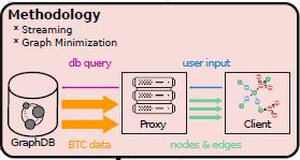Information
- Publication Type: Poster
- Workgroup(s)/Project(s):
- Date: May 2018
- Event: EPILOG
- Conference date: 18. June 2018
Abstract
Analyzing large amounts of data is becoming an ever increasing problem. Bitcoin as an example has produced more data than is possible to analyze. In order to compensate for these difficulties, creative ideas that employ data aggregation or minimization have been proposed. Other work also focuses on introducing novel visualization types that are geared towards the visualization of blockchain data. However, visualization of graphs through node-link diagrams remains a difficult challenge. Analysis of the Bitcoin transaction graph to follow bitcoin (BTC) transactions (TXs) poses a difficult problem due to the Bitcoin protocol and the amount of data. This thesis combines two data processing strategies to visualize big network data on commodity hardware. The idea is to use visualization as a technique to analyze a data-set containing Bitcoin transaction information. Criminals use Bitcoin as a means of payment because of its guaranteed pseudonymity. Through visualization we aim to identify patterns that will allow us to deanonymize transactions. To do so we use a proxy server that does data preprocessing before they are visualized on a web client. The proxy leverages parallel computing to be able to do top-down and bottom-up data processing fast enough for interactive visualization. This is done through incremental loading (bottom-up), which enables to visualize data immediately without a (pre-)processing delay. The database containing the public Bitcoin ledger is over 163 gigabytes in size. The resulting graph has more than 800 million nodes. As this information is too much to be visualized, we also employ a top-down approach of data aggregation and graph minimization of the transactional graph. Through this methodology we intend to solve performance problems of long processing delays and the problem of fractured data where the data is shown only partially in the visualization. We collaborate with security experts who share insights into their expertise through a continuously ongoing dialog. Exploratory analysis on a big data-set such as the Bitcoin ledger, enabled through the methodology presented in this thesis, will help security experts to analyze the money flow in a financial network that is used by criminals for its anonymity. We evaluate the result through the performance and feedback of these security experts as well as benchmark the performance against current best practice approaches.Additional Files and Images
Weblinks
No further information available.BibTeX
@misc{gusenbauer-2018-P,
title = "Bitstream - Top-Down/Bottom-Up Data Processing for
Interactive Bitcoin Visualization.",
author = "Matthias Gusenbauer",
year = "2018",
abstract = "Analyzing large amounts of data is becoming an ever
increasing problem. Bitcoin as an example has produced more
data than is possible to analyze. In order to compensate for
these difficulties, creative ideas that employ data
aggregation or minimization have been proposed. Other work
also focuses on introducing novel visualization types that
are geared towards the visualization of blockchain data.
However, visualization of graphs through node-link diagrams
remains a difficult challenge. Analysis of the Bitcoin
transaction graph to follow bitcoin (BTC) transactions (TXs)
poses a difficult problem due to the Bitcoin protocol and
the amount of data. This thesis combines two data processing
strategies to visualize big network data on commodity
hardware. The idea is to use visualization as a technique to
analyze a data-set containing Bitcoin transaction
information. Criminals use Bitcoin as a means of payment
because of its guaranteed pseudonymity. Through
visualization we aim to identify patterns that will allow us
to deanonymize transactions. To do so we use a proxy server
that does data preprocessing before they are visualized on a
web client. The proxy leverages parallel computing to be
able to do top-down and bottom-up data processing fast
enough for interactive visualization. This is done through
incremental loading (bottom-up), which enables to visualize
data immediately without a (pre-)processing delay. The
database containing the public Bitcoin ledger is over 163
gigabytes in size. The resulting graph has more than 800
million nodes. As this information is too much to be
visualized, we also employ a top-down approach of data
aggregation and graph minimization of the transactional
graph. Through this methodology we intend to solve
performance problems of long processing delays and the
problem of fractured data where the data is shown only
partially in the visualization. We collaborate with security
experts who share insights into their expertise through a
continuously ongoing dialog. Exploratory analysis on a big
data-set such as the Bitcoin ledger, enabled through the
methodology presented in this thesis, will help security
experts to analyze the money flow in a financial network
that is used by criminals for its anonymity. We evaluate the
result through the performance and feedback of these
security experts as well as benchmark the performance
against current best practice approaches.",
month = may,
event = "EPILOG",
Conference date = "Poster presented at EPILOG (2018-06-18)",
URL = "https://www.cg.tuwien.ac.at/research/publications/2018/gusenbauer-2018-P/",
}

 image
image
